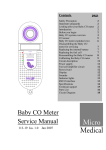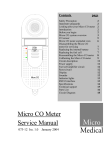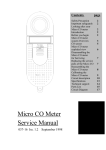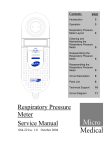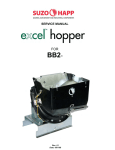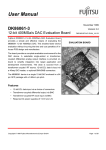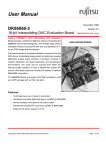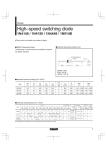Download Smoke Check Service Manual
Transcript
Contents Safety Precaution Important safeguards Looking after your Smoke Check Introduction Before you begin Smoke Check system overview CO sensor Smoke Check exploded view Disassembling the Smoke Check meter for servicing Replacing the internal battery Replacing the fuel cell Reassembling the Smoke Check Calibrating the Smoke Check Circuit description Power supply Fuel cell conditioning circuit Fuel cell amplifier A/D converter Reset circuit Display Sounder Indicator lights RS232 interface Specifications Technical support Parts List Circuit Diagram ON OFF sm oke Smoke Check Service Manual 041-08 Iss. 1.0 page September 2000 2 2 2 2 2 3 5 6 7 7 7 8 9 11 11 12 12 12 13 13 13 13 14 14 15 16 18 Smoke Check Service Manual Information in this document is subject to change without notice and does not represent a commitment on the part of Micro Medical Limited. Only the parts supplied by Micro Medical Limited should be used to complete the service operation described in this manual. If in any way you feel unsure about the successful completion of the service operation you should contact Micro Medical Limited or its appointed agent in your country or region and arrange the despatch of the product to a Micro Medical Limited Service Centre. Copyright 2000 by Micro Medical Limited All rights reserved Drawing no. 041-08 Version 1.0 September 2000 All other products are trademarks or registered trademarks of their respective owners. 1 Safety Precaution The servicing of this device is intended to be carried out by a properly trained and competent electronics engineer, or experienced in the maintenance and servicing of medical devices. Read this manual thoroughly before proceeding with the service. If in any doubt please contact the service centre at Micro Medical Limited or their accredited agent in your country or region. Important Safeguards ο Read all of the instructions. ο Keep the instructions in a safe place for later use. ο Follow all warnings and instructions marked on the product. ο When replacement parts are required, be sure to use replacement parts specified by Micro Medical that have the same characteristics as the original parts. Unauthorised substitutions may result in fire, electric shock or other hazards. ο Do not place on an unstable table. ο The product should be operated only from the type of power source indicated on the label. Looking after your Smoke Check ο Avoid exposing the Smoke Check to direct sunlight. ο Avoid operating the Smoke Check in dusty conditions or near to heating appliances or radiators. ο Do not keep the Smoke Check in a damp place or expose it to extreme temperatures. Introduction This service manual provides you with information to carry out the servicing of the Smoke Check. It is a process, which is relatively straightforward but must be carried out in a logical sequence. Our advice is to familiarise yourself with the contents of this manual before attempting to carry out the procedure of replacing the parts supplied in the sensor replacement kit for the Smoke Check. Before You Begin Before you begin the servicing operation, please read the section on Circuit description very carefully: 2 Smoke Check system overview. The Micro Medical Smoke Check consists of a hand held microcomputer unit (1) incorporating a CO sensor and is supplied with a mouthpiece adapter with integral one way valve and flow restrictor (2) together with disposable cardboard mouthpieces (5). The microcomputer unit is powered by a single alkaline PP3 battery (4) and is supplied with a reducing connector (3) and rod (6) for calibration 1 2 3 ON OFF 4 sm oke 5 6 3 The CO sensor is an electrochemical fuel cell, and works through the reaction of carbon monoxide at one electrode and oxygen (from ambient air) at the other. This reaction generates an electrical current proportional to the concentration of CO exposed to the sensing surface of the fuel cell. The current output signal from the sensor is conditioned using a current to voltage converter and is applied to an analogue port of the microprocessor. When the unit is first switched on the microprocessor records the baseline analogue reading and uses this value to auto zero the instrument. The subject is then requested to breathe in maximally, hold the breath for 20 seconds, and then to expire fully through the mouthpiece connected to the Smoke Check with the mouthpiece adapter. As an aid to timing the breath holding period the legend ‘WAIT’ is displayed until the 20 seconds has elapsed. The microprocessor then records the peak value obtained and displays this on a custom LCD display in the ranges given below. As a quick guide to the estimated smoking level, red, amber and green indicator lights are also provided. The following levels of CO activate these lights: CO(ppm) 0-6 7 -10 11 – 20 20+ Cigarette consumption Non smoker Light smoker Heavy smoker Very heavy smoker 4 Indicator Green Amber Red Flashing red + alarm CO Sensor The sensor is an electrochemical micro fuel cell using gaseous diffusion barrier technology resulting in a direct response to volume concentration rather than partial pressure as with other fuel cells. The cell has two electrodes, a counter electrode and a working electrode separated by a thin layer of electrolyte. The gaseous diffusion barrier limits the flow of gas to the sensing electrode and ensures the electrochemical activity of the electrode is far in excess of the amount of gas with which it has to deal. Gas diffusing onto the sensing electrode reacts at the surface of the electrode by oxidation. CO reacts at the sensing electrode according to the equation: CO + H2O → CO2 + 2H+ + 2eThe counter electrode acts to balance out the reaction at the sensing electrode by reducing oxygen in air to water: ½O2 + 2H+ + 2e- → 2 H2O 5 Smoke Check exploded view ITEM 1 ITEM 2 ITEM 3 ITEM 4 ITEM 5 ITEM 6 ITEM 8 ITEM 7 6 Disassembling the Smoke Check for servicing. The Smoke Check microcontroller unit comprises of a solid state electronic circuit in a robust ABS housing and does not require any preventative maintenance. Routine maintenance consists of replacing an exhausted fuel cell. The fuel cell exhibits a gradual loss of sensitivity with time and has effectively expired when the unit can no longer be calibrated. When the fuel cell has expired, replace by following the procedure below. 1. Turn the unit face down and slide back the battery compartment. 2. Remove the PP3 battery. 3. Remove the 2 self tapping screws (Item 1) and put to one side. 4. Lift the top moulding (Item 6) from the bottom moulding (Item 2). 5. Remove the PCB (Item 3) from the bottom moulding. 6. Carefully remove the fuel cell (Item 4) by gently pulling away from the PCB. Replacing fuel cell of the Smoke Check. 1 Remove the CO sensor (Cat No: CEL4100) from the plastic container. 2 Insert the new cell into the PCB. Reassembling the Smoke Check 1. Place the PCB into the bottom moulding. 2. Tuck the battery strap between the battery and the side wall of the bottom moulding, away from the slide switch. 3. Ensure that the slide switch (item 7) and the switch plate on the top moulding (item 8) are both positioned at the bottom of their travel. 4. Place the top moulding on top of the bottom moulding and secure using the two self-tapping screws. 5. Reconnect the PP3 battery ensuring correct polarity. 7 Calibrating the CO meter Plastic Tubing Control Valve Flow Indicator Reducing Connector for Calibration 20 ppm carbon monoxide in air 1. Set up the calibration equipment as shown above. 8 2. Locate the calibration button positioned on the right hand side of the Smoke Check: Calibration button 3. Turn the Smoke Check on and wait for the unit to display ‘BLOW’. 4. Supply a flow of 20 ppm CO in air at a rate of approximately 0.25 l/min for 25 seconds. 5. Depress the calibration button, using the rod supplied, and three short beeps will be heard as the calibration is recorded. 6. The unit is now ready for operation. 9 Circuit description (Refer to the parts list and circuit diagram) The circuit is based on the Microchip one time programmable (OTP) PIC controller, PIC16C711 (U2) operating at a clock frequency of approximately 4 MHz. This processor contains 1 Kbytes of EPROM, 68 Bytes of RAM, 13 programmable I/O pins, and a 4 channel 8-bit analogue to digital converter (A/D). The current output signal from the sensor is conditioned using a current to voltage converter, offset to 1.25 volts above power ground, and is applied to an A/D port of the controller. Voltage derived the external PP3 battery are also connected to an A/D port. When the unit is first switched on the microprocessor records the baseline reading from the A/D and uses this value to auto-zero the instrument. The signal from the CO sensor is continuously monitored and the peak of the calculated carbon monoxide concentration recorded and the relevant range is displayed. The signal representing the battery voltage is only monitored once when the unit is switched on. Power Supply The externally accessible alkaline 9 volt PP3 battery (BAT 1) provides the power supply. The switch (SW1) controls the battery supply with reverse polarity protection provided by D6. The low drop-out regulator, U3, and associated smoothing capacitors (C3, C4, C6 and C7) provides 5 volts (VDD) to the circuit. The battery voltage is monitored by analogue channel 2 (pin 1) of the controller. The battery voltage halved by R11 and R12 to bring the voltage within the range of the A/D port (5 volts). Fuel cell amplifier circuit. The fuel cell provides an output current, from the working electrode, proportional to the concentration of target gas at the sensing surface. This current is converted to a voltage by the action of U1 and the associated passive components at a transfer factor of 2.1 mV/nA. The feedback network consisting of R1, R2, C1 and the thermistor TH1 provide signal filtering and temperature compensation. R3 is not used and the link is cut. The output of U1 is applied to analogue channel 3 (pin2) of the controller. The sensitivity of the CO fuel cell is 0.03 +/- 0.06µA giving a nominal output of 94.5 mV/ppm CO. 10 Reset Circuit This consists of D1, R4, R5 and C2. Upon switch on this circuit provides a delayed rise to the reset (pin 4) of the controller. The diode ensures rapid discharge of the capacitor upon switch off. Oscillator Circuit A RC oscillator circuit is formed by R16 and C8 connected to pin 16 of the controller, which provides the clock frequency. Please note that the capacitance of the circuit tracks in the oscillator section adds to that of C8 to obtain the correct clock frequency of 4 MHz. Display The display is a custom low power LCD. The legends are controlled by square waves produced by port B of the controller (pins 6 to 13). The backplane is driven by a square wave of nominally 60Hz from port A (pin 17). The individual legends are driven by a similar square wave that is in phase with the backplane when the segment is off and 180 degrees out of phase when the segment is on. Indicator lights The three indicator LED’s, together with a current limiting resistor and reverse voltage blocking diode, are connected between their corresponding legends on the display and the backplane. Only when a legend is activated will a square wave appear across the LED circuit. EEPROM The calibration value is stored in a 1K serial EEPROM, U4. U4 is activated when pin 18 of the controller is set high. The CLOCK and DATA lines are controlled by the microprocessor’s pins 13 and 12 respectively. The binary calibration value is written to the EEPROM only when the calibration button is pressed, and is retreived from EEPROM every time the unit is switched on. Sounder The sounder is operated by a 800 Hz square wave generated by pin 18. 11 Calibration switch The switch SW2 pulls pin 3 to ground when pressed. This pin is polled by the microprocessor and a logic low signals that the current input value should be stored as the calibration value. Specifications Sensor type Range Detected levels: 0 to 6ppm 7 to 10ppm 11 to 20ppm >20 ppm Accuracy Sensitivity drift Sensor life Response time Hydrogen cross sensitivity Operating temperature Operating pressure Pressure coefficient Relative humidity (Non condensing) Baseline drift Long term drift Power source Battery life Weight Dimensions Display Storage temperature Storage humidity Electro-chemical fuel cell 0 - 20 ppm Display: 0-6 ppm with green indicator 7-10 ppm with amber indicator 11-20 ppm with red indicator 20+ ppm with red indicator + alarm +/-5% of full scale or 1ppm whichever is the greater 0.5%/OC 2 to 5 years < 15 sec (to 90% of reading) <15% 15 - 25 OC Atmospheric +/- 10% 0.02% signal per mBar 15 - 90% continuous (0 - 99% intermittent) 0ppm (auto-zero) < 2% signal loss per month Single Alkaline 9 volt PP3 > 8000 tests 130g without battery 170 x 60 x 26 mm Custom LCD -20O to +70O 30% to 75% 12 Technical Support Great Britain and World Headquarters Micro Medical Ltd PO Box 6 Rochester Kent ME1 2AZ Telephone + 44 (0)1634 360044 Fax +44 (0)1634 360055 Web Site http://www.micromedical.com.uk Email [email protected] Contact Micro Medical Ltd for the local agent in your region or country for local service: 13 Parts List Designation C1 C2 C3 C4 C5 C6 C7 C8 CO CELL D1 D2 D3 D4 D5 D6 DISPLAY LED1 LED2 LED3 R1 R2 R3 R4 R5 R6 R7 R8 R9 R10 R11 R12 R13 R14 R15 R16 R17 SK1 SK2 SPKR SW1 SW2 TH1 TR1 U1 U2 U3 U4 Description 0.1µF CERAMIC CAPACITOR 0.1” LEAD SPACING (667-470) 10uF ELECTROLYTIC CAPACITOR (667-419) 100uF ELECTROLYTIC CAPACITOR (667-470) 10uF ELECTROLYTIC CAPACITOR 33pF CERAMIC CAPACITOR 0.1” LEAD SPACING 0.1µF CERAMIC CAPACITOR 0.1” LEAD SPACING 0.1µF CERAMIC CAPACITOR 0.1” LEAD SPACING 22pF CERAMIC CAPACITOR 0.1” LEAD SPACING (MID1-40) 1000 ppm CO CELL FROM SIXTH SENSE (1N4448) SMALL SIGNAL DIODE (1N4448) SMALL SIGNAL DIODE (1N4448) SMALL SIGNAL DIODE (1N4448) SMALL SIGNAL DIODE (1N4448) SMALL SIGNAL DIODE (1N4448) SMALL SIGNAL DIODE (041-06) CUSTOM DISPLAY (637-129) KINGBRIGHT 3mm GREEN LED (322-507) HP HLMP1440 3mm YELLOW LED (637-142) KINGBRIGHT 3mm RED LED 100K 0.25 WATT 5% CARBON FILM RESISTOR 1M 0.25 WATT 5% CARBON FILM RESISTOR NOT USED 1K 0.25 WATT 5% CARBON FILM RESISTOR 39K 0.25 WATT 5% CARBON FILM RESISTOR 820 OHM 0.25 WATT 5% CARBON FILM RESISTOR 820 OHM 0.25 WATT 5% CARBON FILM RESISTOR 820 OHM 0.25 WATT 5% CARBON FILM RESISTOR 10K 0.25 WATT 5% CARBON FILM RESISTOR 1K 0.25 WATT 5% CARBON FILM RESISTOR 10K 0.25 WATT 5% CARBON FILM RESISTOR 10K 0.25 WATT 5% CARBON FILM RESISTOR 10K 0.25 WATT 5% CARBON FILM RESISTOR 1K 0.25 WATT 5% CARBON FILM RESISTOR 10K 0.25 WATT 5% CARBON FILM RESISTOR 5K6 0.25 WATT 5% CARBON FILM RESISTOR 10K 0.25 WATT 5% CARBON FILM RESISTOR (450-1804-01-03-00) SOCKET FROM CAMBION (450-1804-01-03-00) SOCKET FROM CAMBION (PT-1550W) DAU COMPONENTS PIEZO CERAMIC SOUNDER (SLF2300) DOUBLE POLE 3 POSITION SLIDE SWITCH (312-1100) MULTICOMP PUSHBUTTON SWITCH (DKD105NS) THERMOMETRIC 1MEG THERMISTOR (TC04BCZM) 1.25V PRECISION BANDGAP REFERENCE (OP90G) 8-PIN DIL PRECISION OP-AMP (PIC16C711 04/P) OTP MICROCONTROLLER (LM2931M5.0) LOW DROP OUT SURFACE MOUNT 5 VOLT REGULATOR (24LC01) MICROCHIP 1K SERIAL CMOS EEPROM 14















